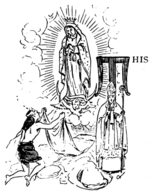Face to Face with the Mexicans/Chapter 14
CHAPTER XIV.
THE VIRGIN OF GUADALUPE.

The subject of Guadalupe has been one of such intense interest, that about sixty-one Mexican and Spanish writers have written elaborately on it. So prominent is she, that thousands of children are annually christened by her name.
The tradition, as generally believed, is as follows: "At an early hour on the morning of December 9, 1531, Juan Diego, a humble Indian, who had been recently converted to the Catholic faith, was quietly pursuing his way from a town adjacent to the City of Mexico, to mass. Pausing for a moment at the foot of a mountain known as the Cerro del Tepazac, which is about three miles from the city, he was held spell bound by sweet and sonorous singing, which seemed to proceed from a great number of birds that sang in perfect accord and harmony.
"It seemed to him that the entire rocky hill above him was vibrating and echoing the sweet notes of the myriad, tiny-throated warblers, and raising his eyes to that point, he beheld a beautiful rainbow, formed from the brilliant rays reflected from the center of the cloud. The Indian was held in silent wonder and admiration, but without fear he stood, contemplating in his heart the strange revelation.
"Ere he had recovered from his surprise, the singing ceased, and at once there issued from the clouds a voice, soft and gentle as a woman's, calling him by name, 'Juan,' and begging him to draw near.
"He hastened to climb the hill, and there he beheld in the midst of the light a most beautiful lady, whose clothing, he said, shone so brightly that the rays from it lighted up the rough cliffs of the rocks which rise from the summit of the hill until they seemed to him like precious stones, cut and made transparent; and the leaves of the prickly pear, which are small and stubby at this point, on account of the barrenness of the place, seemed to him like clusters of fine emeralds, and their branches, trunks, and thorns like shining gold; and even the ground of a small plane on the summit appeared to him to be of jasper, dotted with different colors.
"The lady, with gentle, smiling face, spoke to him in the Mexican language, and told him that she was the Virgin Mary, the true Mother of God, and that she wished to have a temple in that place, where all those who loved her and sought her might come for comfort in their afflictions.
"She commanded him to go to the palace in the City of Mexico and tell the Bishop of her desire.
"The Indian threw himself upon his knees and promised to obey her commands. According to promise, he went directly to the house of the Bishop, to which he gained admittance only after great trouble and delay. Being at last in the presence of his lordship, he fell upon his knees and delivered his message.
"The Bishop was much astonished at the communication, and judging it to be a dream or an imagination of the Indian, he sent him away, telling him to return in a few days, after he had had more time to consider it.
"Juan Diego, sad and disheartened, returned on the same day as the sun was setting. When he reached the hill, he found the Virgin again awaiting him.
"She repeated her commands, and the Indian promised to return on the following day.
"He kept his promise, and the Bishop told him to go back to the Virgin and ask for some sign, and sent with him a servant.
"When they reached the hill, the Virgin was there awaiting him. She still repeated her commands, and he then went home, finding one of his uncles dangerously ill. They sent him to the city for a priest to deliver extreme unction. He thought to avoid the Virgin by passing at the foot of the hill, and what was his surprise to find her descending the hill to meet him.
"At this, the fourth apparition, she gave him the desired sign, telling him to go to the rugged rocks, where nothing had ever been known to grow, and there he would find fresh, sweet, Spanish roses, covered with dew.
"The Indian did as he was bid, and found the roses as she had promised. He filled his blanket with them and took them to the Bishop.
"There in the presence of his worship and numerous attendants, he threw the roses on the floor, and as the blanket unfolded, they beheld with astonishment the image of the Virgin imprinted upon it.
"They then became convinced that the apparitions were genuine, and set about to erect the church on the Cerro del Tepazac, where the vision had appeared."
The tilma, or blanket, which received the marvelous imprint of the Virgin, is still preserved sacredly in the Cathedral of Guadalupe, and visitors, by paying a small fee to the sacristan, may see it.